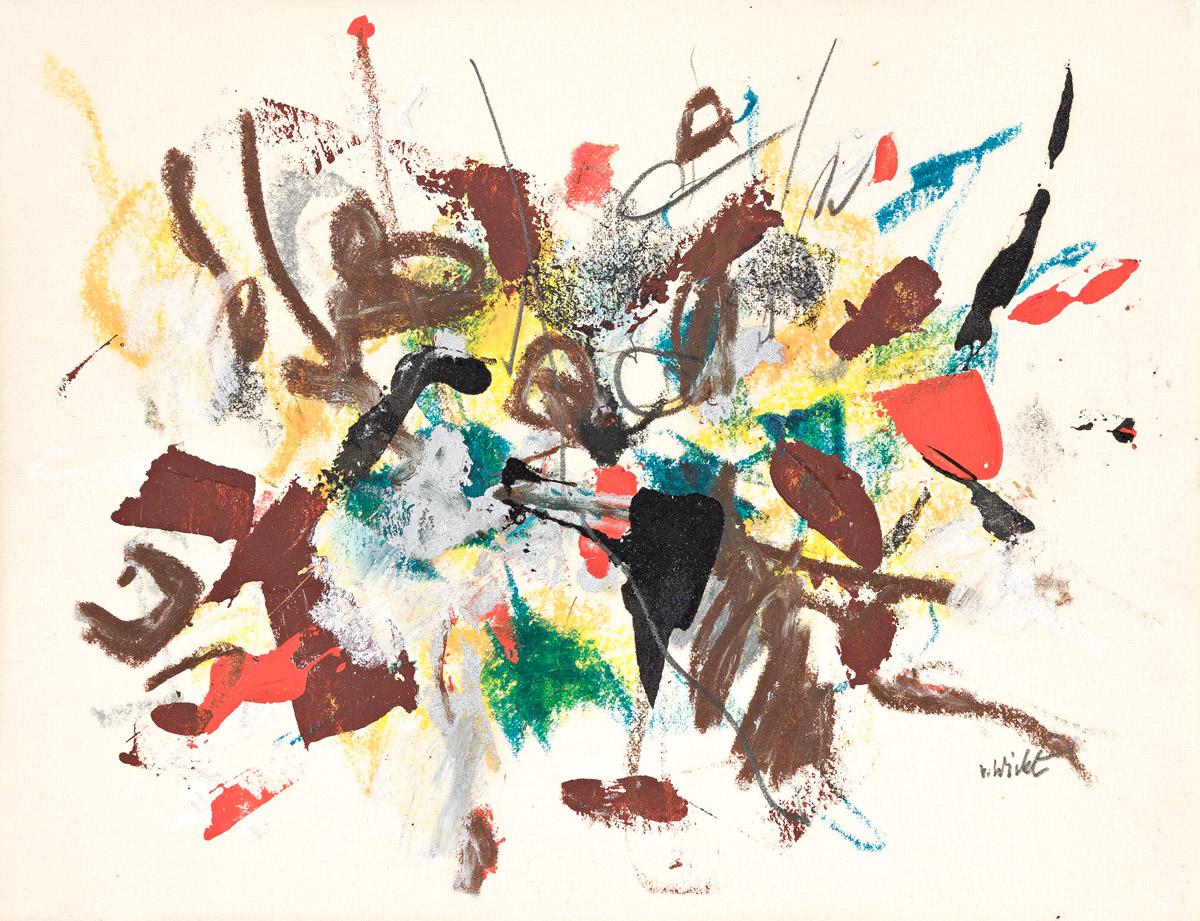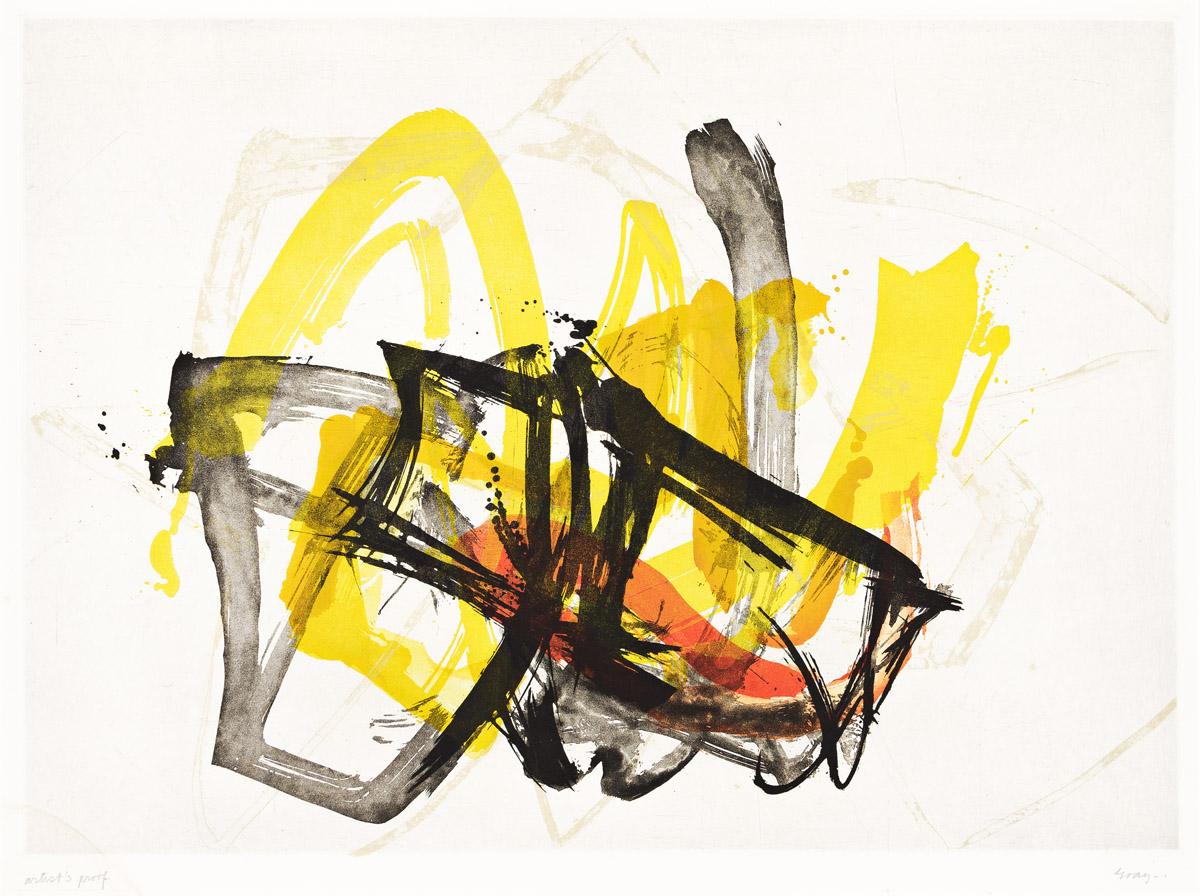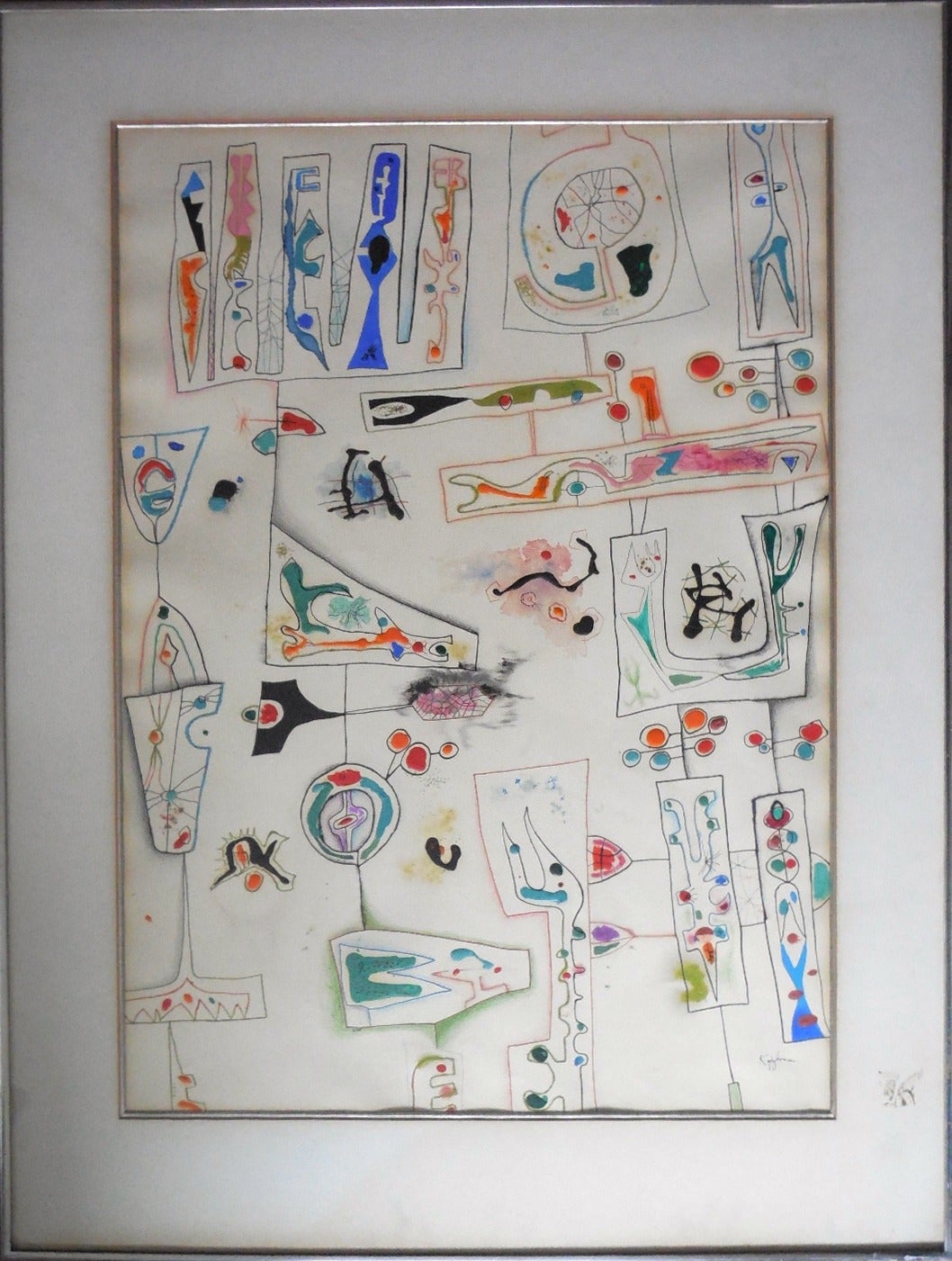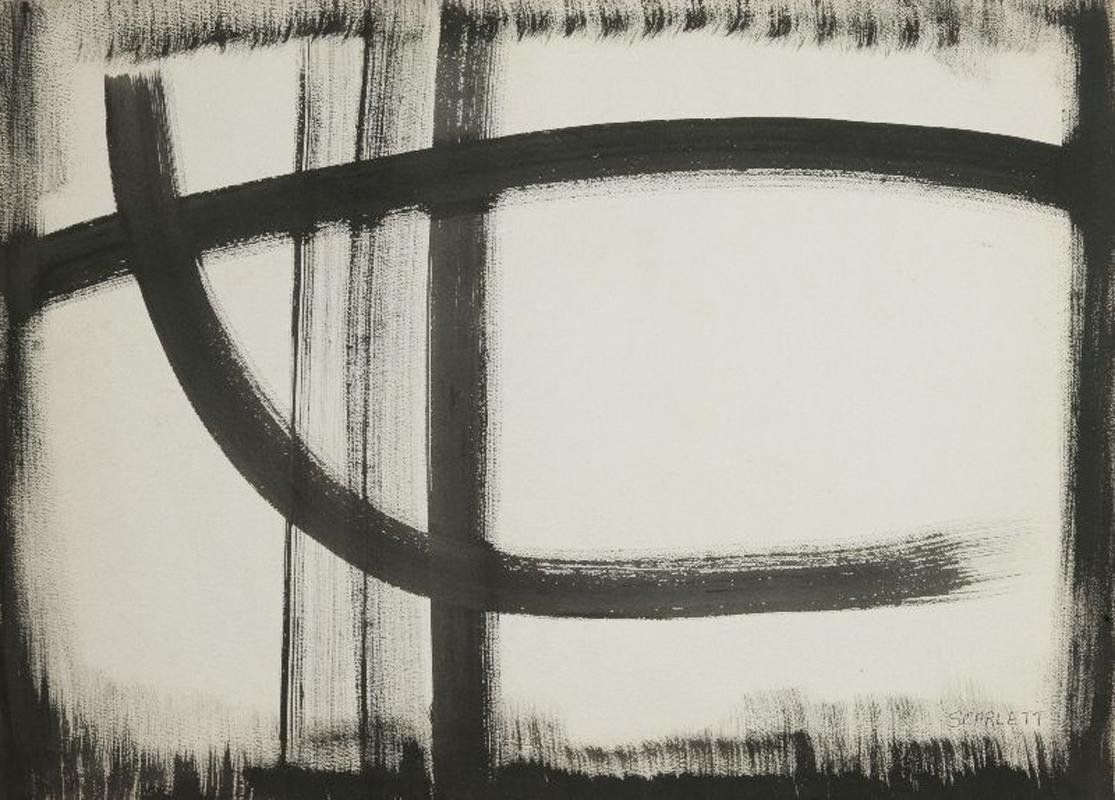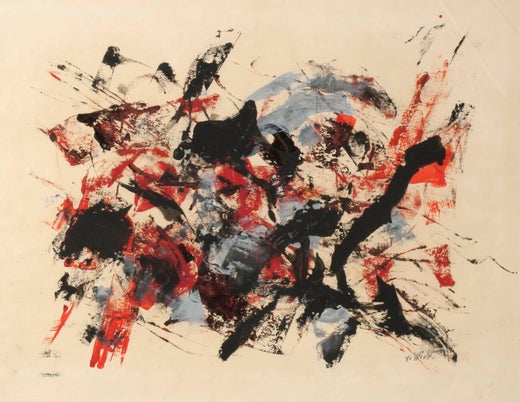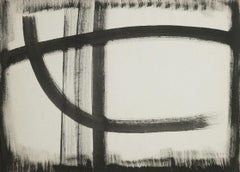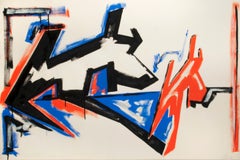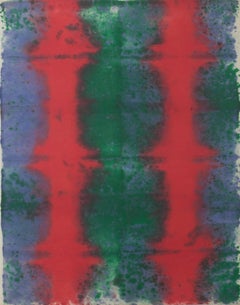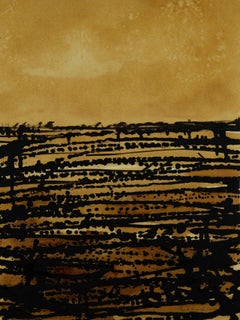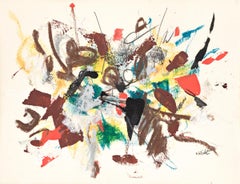Items Similar to Untitled Abstraction
Want more images or videos?
Request additional images or videos from the seller
1 of 11
John von WichtUntitled Abstractionc. 1960's
c. 1960's
$2,750
£2,083.65
€2,390.82
CA$3,869.69
A$4,253.86
CHF 2,235.63
MX$51,657.33
NOK 27,888.96
SEK 26,422.83
DKK 17,843.29
About the Item
Untitled Abstrraction
Gouache, watercolor and pigments on paper, c. 1960
Signed lower right in pencil (see photo)
Image: 17 x 22 inches
Sheet: 25 1/4 x 29 3/4 inches
Frame: 25 1/4 x 29 3/4 inches
Archival framing with OP3 Acrylic
"John von Wicht was highly trained in fine and applied arts in his native Germany before he immigrated to the United States in 1923. When he was seventeen he apprenticed in a painting and decorating shop, and spent his spare time drawing from nature. He began painting in oil about 1908, and soon thereafter sold his first canvas. Encouraged that her son would have a future as an artist, von Wicht’s mother sent him to the advanced private school of the Grand Duke of Hesse, where the professors encouraged students to draw plants and flowers to learn about organic growth, shape and proportion. “I remember the Professor speaking of circular movements, of space between forms and of Equilibrium,” von Wicht later recalled.(1) The students also studied ancient art, Chinese and Japanese calligraphy, as well as Mathias Grünewald, Albrecht Dürer, Martin Schongauer, Hans Memling, and other German masters whose work was in local collections. Von Wicht subsequently studied printing methods at the Royal School for Fine and Applied Arts in Berlin, but said he skipped class frequently to visit exhibitions of the newest painting — van Gogh, Cézanne, Munch, Gauguin, Kandinsky, and Franz Marc.
Wounded and partially paralyzed in the trenches during World War I, von Wicht spent several years recovering, doing book design and illustration work, and looking at art. It was during this recuperation that he discovered Mondrian and Malevich. In 1923, with inflation devastating the German economy, he immigrated to the United States. In New York, his early training served him well. He worked for two years with a lithography company, then joined a firm making stained glass and mosaics. He learned to use symbols rather than naturalistic motifs, and explored both geometry and dense color in abstract paintings such as the Untitled gouache of about 1938, and in murals for radio station WNYC and the New York World’s Fair.
Von Wicht had his first solo show, of mural designs, at the Architect’s Building in 1936. It was followed, in 1939, by an exhibition of his paintings at Theodor A. Kohn Gallery. The show at Kohn was well received by the New York press, and the following year he exhibited at the Whitney Museum of American Art. This exposure cemented von Wicht’s reputation as an abstract painter. Throughout the 1940s, 1950s, and 1960s, he exhibited frequently in solo and group exhibitions in New York and around the country. He was invited to join the American Abstract Artists and the Federation of Modern Painters and Sculptors.
During World War II, von Wicht served as captain of a supply barge ferrying food to army transport ships in New York harbor; after the war he continued to command a supply scow. Harbor themes began to appear in his abstractions, and during the 1950s his sensuously colored geometric abstractions gave way to loose, expressionistic forms. In 1954 von Wicht received the first of twelve annual residencies at the MacDowell Colony in New Hampshire. The spacious studio and contact with other artists at the MacDowell Colony had an important impact on his work. In his exhibition at Passedoit Gallery that year, he exhibited paintings with nautical motifs in which the Cubist device of interlocking and overlapping planes was paramount. But von Wicht also began relating his work to music created by the composers he had met at MacDowell. Although his work was well received from the time of his first exhibition, critics attributed the expanded sense of space, brilliant color, and vigorous handling of paint surfaces in his new work to the experience of living away from the city. By the time he died, in 1970, von Wicht had received international acclaim."
Courtesy Smithsonian American Art Museum
- Creator:John von Wicht (1888-1970, American)
- Creation Year:c. 1960's
- Dimensions:Height: 17 in (43.18 cm)Width: 22 in (55.88 cm)
- Medium:
- Movement & Style:
- Period:
- Condition:Soft crease in upper right corner, threw a portion of the image, but not objectionable. Framed with conservation clear acrylic.
- Gallery Location:Fairlawn, OH
- Reference Number:Seller: FA100251stDibs: LU14013979192
John von Wicht
John von Wicht John von Wicht (German American, 1888–1970) was known for his vibrant, geometric abstractions and later, more expressive compositions. Born in Malente, Germany, von Wicht began his art training at a young age, apprenticing in a painting and decorating shop and later studying lithography, stained glass, and mosaics at the Royal School of Fine and Applied Arts in Berlin. After World War I, he emigrated to the United States in 1923, where he initially worked in stained glass and mosaics. He settled in Brooklyn Heights, and quickly became involved in the American art scene. He exhibited with the American Abstract Artists group and in numerous solo shows in the 1940s, and gained some recognition. His work evolved from structured geometric abstractions to a freer, more emotive style, often inspired by the New York Harbor, where he served as a supply barge captain during World War II.
About the Seller
5.0
Recognized Seller
These prestigious sellers are industry leaders and represent the highest echelon for item quality and design.
Platinum Seller
Premium sellers with a 4.7+ rating and 24-hour response times
Established in 1978
1stDibs seller since 2013
813 sales on 1stDibs
Typical response time: <1 hour
Associations
International Fine Print Dealers Association
- ShippingRetrieving quote...Shipping from: Fairlawn, OH
- Return Policy
Authenticity Guarantee
In the unlikely event there’s an issue with an item’s authenticity, contact us within 1 year for a full refund. DetailsMoney-Back Guarantee
If your item is not as described, is damaged in transit, or does not arrive, contact us within 7 days for a full refund. Details24-Hour Cancellation
You have a 24-hour grace period in which to reconsider your purchase, with no questions asked.Vetted Professional Sellers
Our world-class sellers must adhere to strict standards for service and quality, maintaining the integrity of our listings.Price-Match Guarantee
If you find that a seller listed the same item for a lower price elsewhere, we’ll match it.Trusted Global Delivery
Our best-in-class carrier network provides specialized shipping options worldwide, including custom delivery.More From This Seller
View AllUntitled (Abstraction)
By Rolph Scarlett
Located in Fairlawn, OH
Untitled (Abstraction)
Ink on textured paper, c. 1958
Signed lower right "Scarlett" (see photo)
Condition: Excellent
Archival framing with OP3 Acrylic
Sheet size: 21 3/4 x 30 inches
Frame size: 28 1/2 x 36 1/2 inches
Note: A rare mid to late 1950s example of the artist's abstract expressionist style.
Provenance: estate of the artist
Private Collection, Hudson River Valley, New York
Rolph Scarlett
B. 1889, GUELPH, ONTARIO; D. 1984, WOODSTOCK, NEW YORK
Born on June 13, 1889 in Guelph, Canada, and into an artistic family, Rolph Scarlett spent his teenage years as an apprentice in his uncle’s jewelry firm and briefly studied at the Art Students League, New York. While working in the jewelry industry, Scarlett found time to paint and design theatrical sets in his free time, including one for the 1928 world premiere of Eugene O’Neill’s drama Lazarus Laughed (1926). In 1923, while on a business trip to Switzerland, Scarlett had met the artist Paul Klee and soon after abandoned his figurative painting style in favor of an abstract language that suggested more universal, cosmic truths.
In 1937, after permanently settling in New York, Scarlett became acquainted with the artist and curator Hilla Rebay, the first director of the Museum of Non-Objective Painting (renamed the Solomon R. Guggenheim Museum in 1952). Rebay provided Scarlett with a Guggenheim Foundation scholarship to paint full-time and obtained several of his paintings for the museum’s collection. From 1940 to 1946, Scarlett served as the museum’s chief lecturer, giving Sunday afternoon talks on art. Through Rebay, Scarlett became acquainted with the nonobjective works of Rudolf Bauer and Vasily Kandinsky and further refined his abstract style. Works from this era such as Yellow Bar (1942) are defined by overlapping geometric planes of bright, primary colors set against mute backgrounds. Scarlett avoided any reference to the outside world and believed that nonobjective painting was an act, in his words, of “pure creation.”
During his lifetime, solo shows of his work were held at the Jacques Seligmann Gallery, New York (1949); Sioux City Art Center, Iowa (1951); and Washburn Gallery...
Category
1950s Abstract Abstract Drawings and Watercolors
Materials
Ink
Untitled
By Dennis Ashbaugh
Located in Fairlawn, OH
Untitled (Abstraction)
Mixed media on paper, 1980
Signed and dated 1980 lower right (see photo)
Condition: Excellent, unframed
Sheet size: 31 1/2 x 47 1/2 inches
Provenance: Jan Cowl...
Category
1980s Abstract Expressionist Abstract Paintings
Materials
Mixed Media
Untitled
By Laddie John Dill
Located in Fairlawn, OH
Untitled
Watercolor on paper, c. 1971
Unsigned
From the collection of Ileana Sonnabend (1914-2007)
Laddie John Dill, a Los Angeles artist, had his first solo exhibition in New York C...
Category
1970s Abstract Abstract Drawings and Watercolors
Materials
Watercolor
Untitled
By Ray H. French
Located in Fairlawn, OH
Signed and dated "1962" by the artist lower right.
Mixed media on heavy paper.
Done for a show to fund a trip to Italy.
Category
1960s Abstract Abstract Drawings and Watercolors
Materials
Ink, Mixed Media
Untitled
By Laddie John Dill
Located in Fairlawn, OH
Untitled
Watercolor on paper. 1971
Unsigned
Sheet size: 24 x 19 inches
Condition: Excellent
From the collection of Ileana Sonnabend (1914-2007)
Laddie John Dill, a Los Angeles artist...
Category
1970s Abstract Abstract Drawings and Watercolors
Materials
Watercolor
Untitled
By Laddie John Dill
Located in Fairlawn, OH
Untitled
Watercolor on paper, c. 1971
Unsigned
Provenance: From the collection of Ileana Sonnabend (1914-2007)
Laddie John Dill, a Los Angeles artist, had his first solo exhibition i...
Category
1970s Abstract Abstract Drawings and Watercolors
Materials
Watercolor
You May Also Like
Untitled
By John von Wicht
Located in New York, NY
Oil, gouache and color crayons on paper. Signed i, v. Wicht, lower right recto.
Provenance: private collection, Chicago, IL.
Category
1960s Abstract Expressionist Abstract Paintings
Materials
Crayon, Oil, Gouache
Untitled-055 mixed media abstraction by John Von Wicht
By John von Wicht
Located in Hudson, NY
What is exceptional about this artwork is that it has never been
matted, framed, glued, taped or exposed to light. It is one of a group of over 100 pieces personally selected by the...
Category
1960s Abstract Abstract Drawings and Watercolors
Materials
Paper, Mixed Media
Untitled-113 mixed media abstraction on paper by John Von Wicht
By John von Wicht
Located in Hudson, NY
One of a group of over 100 works personally selected by the artist and gifted to a close personal friend in 1969, this work was never matted, framed, glued, taped or exposed to light...
Category
1950s Abstract Expressionist Abstract Drawings and Watercolors
Materials
Paper, Mixed Media
Untitled
By Cleve Gray
Located in New York, NY
A very good impression of this large, scarce print, color aquatint on white wove Fabriano paper. Artist's proof, aside from the edition of 35. Signed and inscribed "artist's proof" ...
Category
1980s Abstract Expressionist Abstract Prints
Materials
Color, Aquatint
$3,500
Untitled
By Lawrence Kupferman
Located in Surfside, FL
30X21.25 without the frame. Mixed Media painting and drawing on paper. Lawrence Kupferman had a long and illustrious career as an artist and educator. His work has been exhibited at ...
Category
20th Century Abstract Expressionist Abstract Drawings and Watercolors
Materials
Paper, Mixed Media
Untitled, #36 (abstract expressionist painting)
By Esteban Vicente
Located in Wilton Manors, FL
Esteban Vicente (1903-2001). Untitled, #36, 1955. Gouache on paper, image measures 8 x 11 inches, 16.5 x 19.5 inches framed. Signed, dated and numbered on verso. Excellent condition....
Category
Mid-20th Century Abstract Expressionist Abstract Paintings
Materials
Gouache
